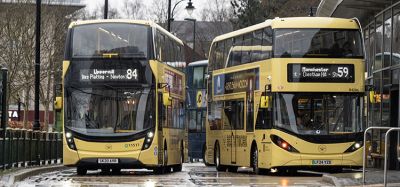ITSO goes live in UK
- Like
- Digg
- Del
- Tumblr
- VKontakte
- Buffer
- Love This
- Odnoklassniki
- Meneame
- Blogger
- Amazon
- Yahoo Mail
- Gmail
- AOL
- Newsvine
- HackerNews
- Evernote
- MySpace
- Mail.ru
- Viadeo
- Line
- Comments
- Yummly
- SMS
- Viber
- Telegram
- Subscribe
- Skype
- Facebook Messenger
- Kakao
- LiveJournal
- Yammer
- Edgar
- Fintel
- Mix
- Instapaper
- Copy Link
Posted: 19 April 2007 | Mike Eastham, GM & Head of Technology and John Verity, Head of Compliance & Security, ITSO | No comments yet
ITSO was founded in 2001 following discussions started in 1998 between the Department for Transport, Public Transport Executives, Transport for London and other interested transport authorities with a desire to generate one interoperable specification for transport related activities. The ITSO specification has now been adopted across the UK and is set for expansion into Europe as operators realise the many advantages it offers.
It may not have hit the front pages of the daily newspapers, but both ISO, the International Organisation for Standardisation, and CEN, its European counterpart, voted unanimously to adopt the new standard ISO 24014-1: 2007 Public transport — Interoperable fare management system, Part 1: Architecture. This is the new standard that all countries have agreed to adopt when implementing Interoperable Fare Management (IFM) systems.
ITSO was founded in 2001 following discussions started in 1998 between the Department for Transport, Public Transport Executives, Transport for London and other interested transport authorities with a desire to generate one interoperable specification for transport related activities. The ITSO specification has now been adopted across the UK and is set for expansion into Europe as operators realise the many advantages it offers. It may not have hit the front pages of the daily newspapers, but both ISO, the International Organisation for Standardisation, and CEN, its European counterpart, voted unanimously to adopt the new standard ISO 24014-1: 2007 Public transport -- Interoperable fare management system, Part 1: Architecture. This is the new standard that all countries have agreed to adopt when implementing Interoperable Fare Management (IFM) systems.
ITSO was founded in 2001 following discussions started in 1998 between the Department for Transport, Public Transport Executives, Transport for London and other interested transport authorities with a desire to generate one interoperable specification for transport related activities. The ITSO specification has now been adopted across the UK and is set for expansion into Europe as operators realise the many advantages it offers.
It may not have hit the front pages of the daily newspapers, but both ISO, the International Organisation for Standardisation, and CEN, its European counterpart, voted unanimously to adopt the new standard ISO 24014-1: 2007 Public transport — Interoperable fare management system, Part 1: Architecture. This is the new standard that all countries have agreed to adopt when implementing Interoperable Fare Management (IFM) systems.
Originally begun as a co-operative exercise between a number of European countries, ISO 24014-1 now has active support from Europe, America, South Africa, Australasia and the Far East. Needless to say, the UK has been involved from the beginning and ITSO already fully complies.
Whilst the standard itself describes what makes up an Interoperable Fare Management system, its players and its roles, ITSO has gone much further and actually put it into reality.
ITSO is now live across all parts of the UK: the devolved Governments in Scotland and Wales have already selected ITSO to hold their concessionary travel scheme products, and a decision on England is expected soon.
ITSO not only provides interoperability allowing any one of, currently, 30 plus different media utilising eight different formats, to securely hold ticket or concessionary products, but also allows the products to operate across different transport modes. Initial implementations have focussed on bus and ferry travel, but the first major rail-based ITSO schemes are in preparation for roll out in the next two years. The South West franchise, to be operated by Stagecoach South West, is the first UK train franchise to adopt ITSO across its whole network, and all subsequent franchises (East and West Midlands, East Coast and Cross Country) are also set to adopt ITSO. As bus, rail, tram and ferry transport providers all move to adopt and implement the ITSO specification, so exciting new opportunities for seam-less multi-modal travel begin to arise, of which PlusBus is just one. It does not take too much imagination to see that there are opportunities here for new products which have up until now been impossible with previous technologies and which can be more dynamic in their operation, simply because the technology can now accommodate it. But care is needed that they don’t become too complex for the customer to understand.
The ITSO specification is an ‘open’ specification, allowing anyone to adopt it free of charge and backward compatibility is built into all upgrades to the specification, Customer Media and Terminal Devices. This is not restraining development and Mike Eastham, ITSO’s General Manager and Head of Technology is already looking at enhancements to allow remote internet retailing, and the use of other electronic devices, such as mobile phones or the new contact-less credit and debit cards to hold ITSO products and tickets.
To encourage developments on a cross-border basis, ITSO has joined with a number of other European countries to lay out a research framework for the next 5 years. John Verity of ITSO is chairing the co-ordinating Research Board. Germany, France, the Netherlands and Italy are all active in this Board together with a swath of other European national players.
One of ITSO’s biggest challenges is working with the UK’s Department for Transport and Transport for London to bring compatibility between ITSO and London’s very successful Oyster scheme. A challenging timeline has been set to get all London’s buses, trams and Tube gate-lines converted to accept ITSO tickets on ITSO cards as well as Oyster.
For each and every commercial operator or retailer, the decision to adopt ITSO has to make commercial sense. It also should be able to bring tangible benefits to the end user if it is ever to gain widespread adoption. Valentina Barker is ITSO’s Marketing Manager and is responsible for ensuring ITSO’s message reaches the key decision makers. As she rightly notes, in England alone there are about 400 different Local Authorities, around 290 local authority concession schemes, 200 bus operators and 26 train companies. Each has high expectations from the level of security necessary to ensure an interoperable fare scheme will work allowing customers to move seamlessly between modes, but ensuring that data is accurately collected and reaches the required recipients without loss. Each player, whether card issuer, retailer or operator, must be registered into the system, a role overseen by Martyn Roper, the ITSO Registrar.
The ITSO Secure Application Module (the ISAM) is the key to identifying each player uniquely, and ensuring all transactions are digitally signed so only the rightful recipient can open, read and verify the content of each transaction. To date over 30,000 ISAMs have been made and issued, and it is the role of the Asset Managers, contracted by the operators to ensure the different products are registered with the ITSO Registrar before use in the field at bus, tram, ferry or rail point of service terminals (a POST in ITSO speak).
The following drivers are seen to be encouraging Interoperable Fare Management Schemes such as ITSO:
- Customers want a universal application, i.e. inter-operability and wide availability with single access to services and quicker journeys
- Transport and public service operators need technology and systems that conform to common standards through out their operations
- Operators desire more accurate distribution of multi-modal revenue pools
- It is also a key driver in the move to transfer cash payment at the point of use to other locations, thus providing potential improvements to dwell times and less cash being carried around by driver and conductors.
Cross scheme, fully interoperable, product development opportunities exist for: electronic purse, loyalty schemes, multi-application cards (e.g. parking, school meals, leisure, and citycards). At an ethical level, smartcards will be held by all sectors of society and their physical appearance and characteristics in use will be identical whether they hold commercial products, or reduced or zero-fare entitlements giving concessionary travel. They thus enhance the effectiveness of social inclusion schemes and help to remove any stigma associated with holding such entitlements.
Unlike existing smartcards which are restricted to specific city or regional geographies, ITSO-based smartcards are designed to allow a single media to be used for multiple transport products in different geographic areas. They are thus expected to bring significantly lower barriers to mobility and encourage the use of public rather than private transport, thereby contributing to a reduction in carbon emissions.
Whilst the ITSO specification allows for the creation of single multi-leg ticketing, these are dependent on the necessary commercial arrangements being in place between the operators of commercial transportation. ITSO believes the more significant contribution to mobility will come from the ability of a customer to use their single smart ticketing media in any participating scheme regardless of the original issuer of the media. This is a big plus for enabling mobility across traditional transit scheme borders.
It also means that those who want to issue (sell) products into customers’ hands do not necessarily need also to be the issuers of the customer media into which the electronic ticket or other product is loaded. As the use of ITSO matures, there could be an opportunity for a different breed of service provider who has a special relationship, on behalf of product providers and whose sole purpose is to look after the customer relationship, possibly providing direct marketing opportunities to enterprises for whom this has hitherto been uneconomic because of a lack of scale.
In short, ITSO is now here to stay, and not just in the UK. The benefits are already on show and cover:
- Integration / Convergence
The new European and international standard: ISO 24014-1 will apply for all Interoperable Fare Management Schemes throughout Europe
- Accessibility / Inclusion
ITSO will bring tangible benefits to mobility and social inclusion
- Consistency
All ITSO operators use the same definitions, the same security processes and all can communicate safely and securely between each other
- Comprehensive
ITSO will provide meaningful end-to-end specifications for Interoperable Fare Management and beyond
- Economy / Value Added
ITSO-based systems will generate significant measurable benefits over equivalent legacy technologies which will become stronger as ITSO becomes more ubiquitous
- Openness
ITSO is an open specification which means that over time ‘off-the-shelf’ solutions will likely become available thus reducing economic barriers to entry for suppliers
The visionaries who first initiated ITSO as a full interoperable specification seem to have got it right in providing an end-to-end specification that has the right balance between open opportunity and security and integrity in use. To slightly rework the old proverb, “the pudding, as they might say, is now ready for the eating.”








